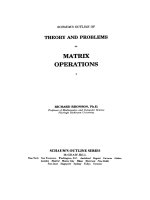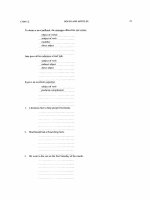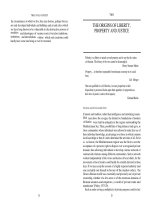schaum s easy outline of principles of economics based on schaum s outline of theory and problems of principl phần 3 doc
Bạn đang xem bản rút gọn của tài liệu. Xem và tải ngay bản đầy đủ của tài liệu tại đây (273.17 KB, 15 trang )
Chapter 3
Unemployment,
Inflation, and
National Income
In This Chapter:
✔ Gross Domestic Output
✔ Aggregate Demand, Aggregate
Supply, and Equilibrium Output
✔ Changes in Aggregate Output
✔ Business Cycles
✔ Unemployment and the Labor Force
✔ Inflation
✔ True or False Questions
✔ Solved Problems
Gross Domestic Output
Gross domestic product (GDP) measures total output in the
domestic economy. Nominal GDP, real GDP, and potential
GDP are three different measures of aggregate output.
Nominal GDP is the market value of all final goods and ser-
vices produced in the domestic economy in a one-year pe-
25
Copyright 2003 by The McGraw-Hill Companies, Inc. Click Here for Terms of Use.
riod at current prices. By this definition, (1) only output exchanged in a
market is included (do-it-yourself services such as cleaning your own
house are not included); (2) output is valued in its final form (output is in
its final form when no further alteration is made to the good which would
change its market value); and (3) output is measured using current-year
prices.
Because nominal GDPvalues are inflated by prices that increase over
time, aggregate output is also measured holding the prices of all goods
and services constant over time. This valuation of GDP at constant prices
is called real GDP.
The third measure of aggregate output is potential GDP, the maxi-
mum production that can take place in the domestic economy without
putting upward pressure on the general level of prices. Conceptually, po-
tential GDP represents a point on a given production-possibility frontier.
The U.S. economy’s potential output increases at a fairly steady rate
each year while actual real GDP fluctuates around potential GDP. These
fluctuations of real GDP are identified as business cycles. The GDP gap
is the difference between potential GDP and real GDP; it is positive when
potential GDP exceeds real GDP and negative when real GDP exceeds
potential GDP. A positive gap indicates that there are unemployed re-
sources and the economy is operating inefficiently within its production-
possibility frontier. It therefore follows that an economy’s rate of unem-
ployment rises as its GDP gap increases, and falls when the gap declines.
An economy is operating above its normal productive capacity when
there is a negative gap.
Aggregate Demand, Aggregate Supply,
and Equilibrium Output
The economy’s equilibrium level of output occurs at the point of inter-
section of aggregate supply and aggregate demand. In microeconomics,
equilibrium price exists where quantity demanded equals quantity sup-
plied. The supply and demand schedules in macroeconomics differ in that
they relate the aggregate quantity supplied and the aggregate quantity de-
manded to the price level.
26 PRINCIPLES OF ECONOMICS
Important Things to Remember
Supply and demand curves may appear similar to
aggregate supply and aggregate demand curves
in graphs, but they are substantially different.
An aggregate demand curve represents the collective spending of
consumers, businesses, and government, as well as net foreign purchas-
es of goods and services, at different price levels. An aggregate demand
curve, like the demand curve in microeconomics, is negatively related to
price, holding constant other factors that influence aggregate spending
decisions.
Price, presented as price level in macroeconomics, affects aggregate
spending because of an interest rate effect, a wealth effect, and an inter-
national purchasing power effect. The interest rate
effect traces the effect that interest rate levels have
upon aggregate spending. The nominal rate of in-
terest is directly related to the price level, ceteris
paribus. Increases in the price level push up interest
rates, which usually will depress interest-sensitive
spending. The wealth effect relates changes in
wealth to changes in aggregate spending. The mar-
ket value of many financial assets falls as price lev-
el and interest rates increase. Ahigher price level will decrease the house-
hold sector’s net wealth, lower consumer spending, and cause lower
aggregate spending. A country’s imports and exports are also affected by
a changing price level, i.e., by an international purchasing power effect.
When the price level increases in the home country and is unchanged in
foreign countries, foreign-made commodities become relatively less ex-
pensive, the home country’s exports fall, its imports increase, and there
is less aggregate spending on the home country’s output.
An aggregate demand curve shifts when there is a change in a vari-
able (other than price level) that affects aggregate spending decisions.
Outward shifts (to the right) occur when consumers become more will-
ing to spend or there are increases in investment spending, government
expenditures, and net exports. Determinants of these factors will be tak-
en up in the next chapter.
CHAPTER 3: Unemployment, Inflation, and Income
27
An aggregate supply schedule depicts the relationship of aggregate
output and price level, holding constant other variables that could affect
supply. There is some disagreement among economists on the shape of
the aggregate supply curve. Three distinct curves can characterize this
disagreement. The Keynesian aggregate supply curve is horizontal until
it reaches the economy’s full-employment level of output, at which point
it becomes positively sloped. Others view the aggregate supply curve as
always being positively sloped. The classical aggregate supply curve is
vertical at the full-employment level, indicating there is no relationship
between aggregate output and the price level.
Changes in economy-wide resource availability, resource cost, and
technology shift the aggregate supply curve. The aggregate supply curve
shifts rightward when (1) improved technology increases the potential
output of a given quantity of resources; (2) the quantity of economic re-
sources increases; or (3) the cost of resources declines.
Changes in Aggregate Output
The effect of changes in aggregate demand and/or aggregate supply upon
equilibrium output and the price level depends upon the shape of the ag-
gregate supply curve. With a Keynesian aggregate supply curve, an in-
crease in aggregate demand affects only output as long as the economy
is below full-employment output, whereas an increase in aggregate sup-
ply has no effect upon either the price level or output. Increases in ag-
gregate demand and/or aggregate supply affect both the price level and
real output when aggregate supply is positively sloped, as can be seen in
Figure 3-1. For a classical aggregate supply curve, increases in aggregate
demand result in only a higher price level, whereas increases in aggre-
gate supply result in a higher level of output and a lower price level.
Example 3.1
Equilibrium real output is y
1
and the price level is p
1
for aggregate sup-
ply and aggregate demand curves ASЈ and ADЈ in Figure 3-1. Increased
government spending shifts the aggregate demand curve outward to ADЉ,
and the point of equilibrium changes from E
1
to E
2
. Equilibrium output
increases from y
1
to y
2
as the price level rises from p
1
to p
2
. When ag-
gregate supply increases to ASЉ and aggregate demand remains at ADЈ,
28 PRINCIPLES OF ECONOMICS
CHAPTER 3: Unemployment, Inflation, and Income 29
the equilibrium point changes from point E
1
to E
3
. Equilibrium output in-
creases from y
1
to y
2
and the price level falls from p
1
to p
0
.
There are two approaches to measuring aggregate output: an expen-
diture approach, which measures the value of final sales, and a cost ap-
proach, which measures the value added in producing final output. The
expenditure or final sales approach consists of summing the consumption
spending of individuals (C), investment spending by businesses (I), gov-
ernment expenditures (G), and net exports (X
n
). [GDP = C + I + G + X
n
].
The cost approach consists of summing the value added to final output at
each stage of production. Gross domestic product consists of all output
produced within the country’s boundaries.
Business Cycles
A business cycle is a cumulative fluctuation in aggregate output that lasts
for some time. Although recurrent, the duration and intensity of each fluc-
tuation varies. Points at which aggregate output changes direction are
marked by peaks and troughs. A peak is a point which marks the end of
economic expansion (rising aggregate output) and the beginning of a re-
cession (decline in economic activity). A trough marks the end of a re-
Figure 3-1
cession and the beginning of economic recovery.
The time span between troughs and peaks is classi-
fied as an expansionary period (trough to peak) or
a contractionary period (peak to trough).
There are a number of explanations for the cyclical behavior of ag-
gregate output. The central focus of many of these theories is investment
spending and consumer purchases of durable goods. These expenditures
consist of large-ticketed items whose purchase, in most cases, can be
postponed. For example, an individual can repair an existing car rather
than purchase a new one. Thus, purchases of such items occur when cred-
it (borrowing) is more readily available or less costly, individuals are
more optimistic about the future, and/or cash flows are more certain.
However no one theory is able to explain why some business cycles are
more severe than others. This suggests that there are numerous causes and
that the importance of each cause varies.
Unemployment and the Labor Force
The U.S. labor force does not include the entire population but only those
who are at least 16 years old, employed, or unemployed and looking for
work. A working-age person who is not looking for work is considered
voluntarily unemployed and is not included in the labor force. Thus, the
size of the labor force and the number of people unemployed can be un-
derstated when a significant number of workers, after some searching, be-
come discouraged and stop looking for work.
The unemployment rate is the percent of the total labor force that is
unemployed. Unemployment arises for frictional, structural, and cyclical
reasons. Frictional unemployment is temporary and occurs when a per-
son (1) quits a current job before securing a new one, (2) is not immedi-
ately hired when entering the labor force, or (3) is let go by a dissatisfied
employer. Workers who lose their jobs due to a change in the demand for
a particular commodity or because of technological advance are struc-
turally unemployed; their unemployment normally lasts for a longer
period since they usually possess specialized skills which are not de-
manded by other employers. Cyclical unemployment is the result of in-
sufficient aggregate demand. Workers have the necessary skills and are
available to work, but there are insufficient jobs because of inadequate
aggregate spending. Cyclical unemployment occurs when real GDP falls
below potential GDP.
30 PRINCIPLES OF ECONOMICS
Note!
In the economist’s definition of unemployment, not
everyone that is without a job is unemployed.
Full employment exists when there is no cyclical unemployment but
normal amounts of frictional and structural unemployment; thus, full em-
ployment exists at an unemployment rate greater than zero. This is re-
ferred to as the natural rate of unemployment. It may change when there
is a change in the normal amount of frictional and structural unemploy-
ment. The cyclical unemployment rate can be negative when real GDP
exceeds potential GDP and the economy is producing beyond its normal
full-employment level. This negative cyclical unemployment rate indi-
cates that the normal job search period for the frictionally and structural-
ly unemployed is shortened because of an abnormally large number of
job openings. Cyclical unemployment imposes costs upon both society
and the person unemployed. Society’s opportunity cost is the amount of
output which is not produced and therefore is lost forever. The personal
costs that occur during an economic downturn are unevenly distributed
between different types of workers.
Example 3.2
Table 3.1 presents the unemployment rate by sex, age, and race in 1992,
when U.S. real GDP was considerably below potential output, and in
1987, when U.S. real GDP equaled potential GDP. Note that the unem-
ployment rate is always higher for teenagers than for those older, and
higher for blacks and others than for whites. This difference worsens
when the economy is below its potential GDP.
Inflation
A price index relates prices in a specific year, month, or quarter to prices
during a reference period. For example, the consumer price index (CPI),
the most frequently quoted price index, relates the prices that urban con-
sumers paid for a fixed basket of approximately 400 goods and services
CHAPTER 3: Unemployment, Inflation, and Income
31
in a given month to the prices that existed during a
reference period. The producer price index (PPI) and
GDP deflator are the other two major price indexes.
The PPI measures the prices for finished goods, in-
termediate materials, and crude materials at the
wholesale level. Because wholesale prices are even-
tually translated into retail prices, changes in the PPI are usually a good
predictor of changes in the CPI. The GDP deflator is the most compre-
hensive measure of the price level since it measures prices for net exports,
investment, and government expenditures, as well as for consumer
spending.
Inflation is the annual rate of increase in the price level. Disinflation
is a term used to denote a slowdown in the rate of inflation; deflation ex-
ists when there is an annual rate of decrease in the price level. While there
have been some monthly decreases in the price level, the U.S. economy
has not experienced deflation since the 1930s.
You Need to Know
Inflation refers to an increase in the general price
level, not the price of a specific good or service.
32 PRINCIPLES OF ECONOMICS
Table 3.1
Economists identify two distinct causes of inflation. Demand-pull in-
flation is inflation that occurs when aggregate spending exceeds the econ-
omy’s normal full-employment level of output, i.e., when aggregate de-
mand is pushed too far to the right along a given aggregate supply curve.
Demand-pull inflation is normally characterized by both a rising price
and output level. It often results in an unemployment rate lower than the
natural rate. Cost-push inflation originates from increases in the cost of
producing goods and services, such as wages or the prices of raw mate-
rials. Aggregate supply is pushed to the left, which is referred to as
stagflation. It is associated with increases in the price level, decreases in
aggregate output, and an increase in the unemployment rate above the
natural rate.
Inflation can slow economic growth, redistribute income and wealth,
and cause economic activity to contract. Inflation impairs decision mak-
ing since it creates uncertainty about future prices and/or costs and
distorts economic values. For example, a business may postpone the pur-
chase of equipment because of increasing uncertainty about the purchas-
ing power of future money streams. Such postponed capital outlays slow
capital formation and economic growth.
True or False Questions
1. Increases in nominal GDP always result in increases in real GDP.
2. Increases in a positive GDP gap are associated with increases in
the unemployment rate.
3. All economists agree that an increase in aggregate demand will re-
sult in an increase in both the price level and real output.
4. A business cycle occurs every two years.
5. Unemployment only imposes a cost upon those who are unem-
ployed.
6. Cyclical unemployment is unevenly distributed among members
of the labor force.
Answers: 1. False; 2. True; 3. False; 4. False; 5. False; 6. True
Solved Problems
Solved Problem 3.1
a. Distinguish between a final good and an intermediate good.
b. Is a loaf of bread a final or an intermediate good?
CHAPTER 3: Unemployment, Inflation, and Income 33
Solution:
a. A final good is one that involves no further processing and is pur-
chased for final use. An intermediate good is one that: (1) involves fur-
ther processing; (2) is being purchased, modified, and then resold by the
purchaser; or (3) is resold during the year for a profit.
b. A loaf of bread could be either a final or intermediate good, de-
pending upon the purchaser’s use of the good. It is a final good when pur-
chased by a household for consumption; it is an intermediate good when
purchased by a deli which resells the bread as part of a sandwich.
Solved Problem 3.2 An economy’s potential output is depicted by the
production-possibility frontier in Figure 3-2.
a. Explain the relationship between potential GDP and real GDP
when output is at point A.
b. What is a GDP gap?
c. Is there a GDP gap for the situation described in part a?
d. Can a GDP gap be negative?
Solution:
a. Point A is within the economy’s production-possibility frontier.
Thus, actual output is less than the economy’s ability to produce, i.e., real
GDP is less than potential GDP.
b. A GDP gap exists when real GDP does not equal potential GDP.
It is measured by subtracting real GDP from potential GDP.
c. There is a positive GDP gap at point A since the economy’s pro-
duction of goods and services is below its ability to produce.
d. The production-possibility frontier measures the economy’s abil-
ity to produce goods and services without putting upward pressure on out-
put prices. The production-possibility frontier can thus be exceeded, but
in doing so there are increases in both output and the price level. Thus, a
negative GDP gap can exist—real GDP can exceed potential GDP—
when real GDP is, for example, at point B in Figure 3-2 and the econo-
my is producing beyond its full-employment level of output.
Solved Problem 3.3 Use aggregate demand and aggregate supply curves
AD and AS in Figure 3-3 to answer the following questions:
a. Is the aggregate supply curve Keynesian or classical?
b. Find the economy’s equilibrium level of output and price level.
c. Does an increase in government spending, ceteris paribus, shift
34 PRINCIPLES OF ECONOMICS
aggregate demand or aggregate supply? What happens to equilibrium
output and the price level?
d. Suppose there is a technological advance rather than an increase
in government spending. What happens to aggregate demand? Aggregate
supply? Equilibrium output? The price level?
CHAPTER 3: Unemployment, Inflation, and Income
35
Figure 3-2
Figure 3-3
Solution:
a. Figure 3-3 depicts a classical aggregate supply curve since it
shows no relationship between aggregate output and the price level.
b. Equilibrium exists where the aggregate demand curve intersects
the aggregate supply curve. Equilibrium for curves AD and AS exists at
point A; the price level is p
0
and output is y
1
.
c. Increased government spending results in an outward shift of ag-
gregate demand. There is no change in aggregate supply since there has
been no change in the economy’s ability to produce goods and services.
If aggregate demand shifts from AD to ADЈ, then equilibrium now exists
at point B. Equilibrium output remains at y
1
and equilibrium prices in-
creases from p
0
to p
2
.
d. The technological advance has no effect on aggregate demand, but
it shifts aggregate supply rightward from AS to ASЈ. Equilibrium changes
from point A to point C. Equilibrium output has increased from y
1
to y
2
,
while the price level has decreased from p
0
to p
1
.
Solved Problem 3.4
a. What effect does unanticipated inflation have upon: (1) individu-
als who are retired and living on a fixed income; (2) debtors, and (3) cred-
itors?
b. How does indexation protect one from the redistribution effect of
inflation?
Solution:
a. (1) Unanticipated inflation lowers the real income of those on a
fixed income. An increase in the price level reduces the purchasing pow-
er of a fixed nominal income; the result is the purchase of fewer goods
and services. (2) Debtors benefit from unanticipated inflation since the
dollars they pay back have less purchasing power. (3) Creditors (lenders),
on the other hand, lose from unanticipated inflation since the dollars they
are repaid purchase fewer goods and services.
b. Indexation ties money payments to a price level so that the sum of
money payments rises proportionately with the price level. For example,
a $20,000 salary would increase to $22,000 when the monetary payments
of $20,000 are indexed and there is a 10 percent increase in the price
level.
36 PRINCIPLES OF ECONOMICS
Chapter 4
Consumption,
Investment, Net
Exports, and
Government
Expenditures
In This Chapter:
✔ Consumption
✔ Investment
✔ Net Exports
✔ Government Taxes and
Expenditures
✔ True or False Questions
✔ Solved Problems
Consumption
Because consumption represents two-thirds of total aggregate spending
in the U.S., understanding the determinants of consumer spending is cen-
tral to any analysis of the economy’s level of output. Consumer spending
37
Copyright 2003 by The McGraw-Hill Companies, Inc. Click Here for Terms of Use.
is largely determined by personal income, income
taxes, consumer expectations, consumer indebted-
ness, wealth, and price level. Since consumption is
impossible for most individuals without income
from employment or through transfers from busi-
ness or government, personal income is the most
important of these variables. Personal income taxes
are also central in that one’s ability to spend de-
pends not upon the income received but on the in-
come available for spending.
A consumption function is the relationship of consumption to dis-
posable income, holding nonincome determinants of consumption con-
stant. Figure 4-1 plots the consumption function for a hypothetical econ-
omy, labeled CЈ. A change in a nonincome determinant of consumption
alters the relationship of consumption to disposable income. Such
changes are depicted graphically by upward or downward shifts of the
consumption function. Shifts of the consumption function affect the lev-
el of consumption and saving.
The 45Њ line in Figure 4-1 is equidistant from both the consumption
and disposable income axes. As drawn, C = Y
d
at each point on this 45Њ
line. For linear consumption function CЈ, there is only one level of dis-
posable income at which consumer spending equals disposable income,
and that is the point of intersection of the consumption line and the 45Њ
line. Since the consumption line is below the 45Њ line at disposable in-
come levels above $500 billion, it follows that consumers are not con-
suming their entire income and therefore are saving. Thus, consumer sav-
ing is the distance between the consumption line and the 45Њ line at each
level of disposable income.
Example 4.1
Should consumers expect an increase in the price level, they are likely to
spend more in the current period before prices rise. An upward shift of
consumption function CЈ to CЉ in Figure 4-1 results. We now find that at
disposable income of $500 billion, consumption exceeds disposable in-
come, i.e., consumers are dissaving. (Consumers can dissave by borrow-
ing or by spending accumulated savings). Consumption now equals dis-
posable income when Y
d
is $600 billion; for consumption function CЉ
there is less saving at each level of disposable income than there is for
consumption function CЈ.
38 PRINCIPLES OF ECONOMICS
The marginal propensity to consume is the ratio of the change in con-
sumption relative to the change in disposable income between two levels
of disposable income (MPC =∆C/∆Y
d
), while the marginal propensity to
save is the ratio of the change in saving relative to the change in dispos-
able income (MPS =∆S/∆Y
d
). Also MPS = 1 − MPC.
Example 4.2
From Figure 4-1, consumption (under CЈ) increases from $500 billion to
$540 billion when disposable income increases from $500 billion to $550
billion; the MPC is therefore 0.80 since ∆C of $40 billion divided by ∆Y
d
CHAPTER 4: Consumption, Investment, Exports and Government 39
ED: Please shorten RH.
Figure 4-1









